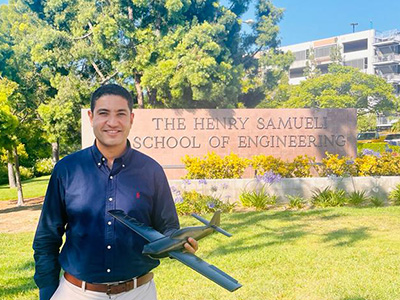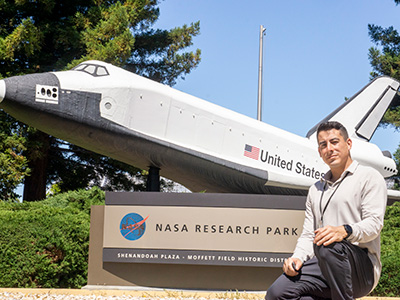Pursuit of ‘Useless’ Knowledge Leads to New Theory of Lift

Haithem Taha (shown), associate professor of mechanical and aerospace engineering, and Cody Gonzalez, mechanical and aerospace engineering graduate student, discovered a new theory of lift, which fundamentally changes how we understand flight. Photo courtesy of Haithem Taha.
July 12, 2022 – Challenging a century-old theory of flight is not an easy journey. In fact, many might consider it a pointless pursuit – especially as millions of people board airplanes without a thought about the aerodynamics that keep them in the air.
However, Haithem Taha, UC Irvine associate professor of mechanical and aerospace engineering, and Cody Gonzalez, mechanical and aerospace engineering graduate student, followed their curiosity into what has been considered “useless” knowledge and discovered a new theory of lift, which fundamentally changes how we understand flight. They have published their work “A Variational Theory of Lift” in the Journal of Fluid Mechanics May 6, 2022, issue.
Taha explained, “This work solves a century-old puzzle in aerodynamics. The way we solved the puzzle is not by a complex microscope, an expensive piece of equipment or an advanced computational tool/algorithm. The intellectual puzzle that lasted over a century is solved by using philosophical principles in classical mechanics that were available to the early pioneers of aviation: [Martin] Kutta, [Nikolai] Zhukovky, [Ludwig] Prandtl, [Theodore] Von Karman among others.”
Currently, the main theory of lift taught in aeronautical engineering schools and found in books on aerodynamics is attributed to German mathematician Martin Kutta, published in 1910, explained Taha. Kutta’s theory is confined to special types of shapes of wing sections: those with a single sharp edge at the rear.
However, Kutta’s theory fails to apply if planes have multiple sharp edges, no sharp edges, a single sharp edge in the front, or even a single rear sharp edge in an unsteady flow. The new theory of lift is generally applicable to all those cases and is derived from first principles in mechanics, in contrast to Kutta’s theory.

Haithem Taha and Cody Gonzalez (shown) have published their work “A Variational Theory of Lift” in the Journal of Fluid Mechanics. Photo courtesy of Cody Gonzalez.
The principle used to resolve this problem, the Hertz principle of least curvature, is rarely found in textbooks of classical physics and analytical mechanics. “I spent several years studying the history and philosophy of mechanics, which is deemed by contemporary metrics as ‘useless’ knowledge; no publications could come of it,” said Taha. “Also, the courage of my doctoral student, Cody Gonzalez, to pursue his curiosity in an idea that seemed outdated and obsolete, and the freedom given to him to go in this direction played a great factor. The fact this pursuit of ‘useless’ knowledge solves one of the fundamental technical challenges in aerodynamics that lasted over a century confirms the premise of Abraham Flexner's thesis ‘The Usefulness of Useless Knowledge.’”
Peer reviewers have commended the work. “It is a breakthrough in theoretical aerodynamics. Some chapters in aerodynamics books will be rewritten,” said Saad Ragab, professor of biomedical engineering and mechanics at Virginia Tech.
Taha and Gonzalez are sharing their discovery with students and a wider audience through a video, which helps explain the work in layperson’s terms.
“It is expected that this theory may replace or be taught side by side to Kutta’s in the undergraduate curriculum of aeronautical engineering schools throughout the world,” said Taha. “Here at UCI, as well as my alma mater, Virginia Tech, and other schools, some colleagues will start teaching it next year. It is rare to discover new findings related to the basic concepts taught at the undergraduate level in engineering schools. On the industry level, this theory may help create new shapes for wings in the future.”
– Tonya Becerra
